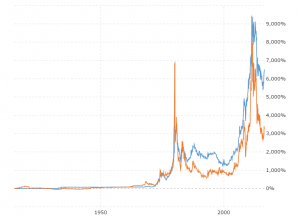Record $5 Million Coin Sale – the Brasher Doubloon
In 1897, workmen digging a cellar in Philadelphia found some coins. One turned out to be a Brasher Doubloon, the rarest American coin there is, and the last-found of only seven examples still in existence. This March one of those coins was sold for over $5 million, almost the highest price ever paid for an American coin.
The coin sold, technically referred to as the Perschke Specimen, MS63 NGC., is the finest of the seven specimens, and one of only three in private hands. It can be traced back to the 1830s, when it was in the hands of a prominent collector of the period, Robert Gilmor Jr. It stayed in the Gilmor family for at least 40 years, before changing hands several times. In 1979 it was owned by Walter Perschke, a Chicago coin dealer, who often loaned it for public exhibition. Pershke died in 2016, and now the coin has re-emerged in this latest sale.
A non-disclosure agreement stops us from knowing complete details of the sale, but we can perhaps reasonably assume the seller is the Pershke estate. On one side of the deal is the world’s largest rare coin auction house, Heritage Auctions, who brokered the deal on behalf of an anonymous West Coast collector, with Todd Imhof, Executive Vice President acting for Heritage. Appropriately the ostensible buyer is based in the billionaires’ capital of the world, Monaco, since the other side is of the deal is Adam Crum, an American coin authority, and vice-president of Monaco Rare Coins.
Ephraim Brasher was a silversmith who lived on Cherry Street in Manhattan, right next door to President George Washington, who we know made various purchases from Brasher. In the 18th century this was a fashionable part of the city, just north of where Brooklyn Bridge now enters the island. At this time the currency in circulation in the young nation was a mixture of foreign coins, private coins and government sponsored copper coins. There were many counterfeit and below-weight coins in circulation too, so an annual assay of the stock was needed. We know that Brasher was employed for this assay, as his mark can be found on coins from this period. Spanish Doubloons were popular and widely used, and it seems that Brasher began making private-issue gold doubloons modelled on them as early as 1742.
He was also making private copper coins, and in 1787 he applied for a state franchise to produce the government coins then in use. His petition was denied, but in the same year he produced his famous New York Style Gold Doubloons. Three purposes have been suggested for them. They may have been samples from his copper coin moulds. They may have been souvenirs for visitors to Washington, next door to his shop. Or they may have been for use by merchants for large-value transactions. In any case, these coins have become the rarest American coins.
The obverse is an adaption of the coat of arms of New York. The sun is rising over the peak of a mountain with a body of water in the foreground. Brasher’s name is spelled out below the waves, in small letters, within a circle of beads. The words, NOVA EBORACA COLUMBIA EXCELSIOR, meaning, ‘New York, America, Ever Higher’, surrounds the image.
The reverse is very similar to the Great Seal of the United States, with an eagle clutching a bundle of arrows in one claw and an olive branch in the other. The words, UNUM E PLURIBUS surround the eagle. Brasher’s stamp, ‘EB’ is on the left wing. The coin weighs 26,66 grams, and is 89% pure gold, 6% silver and 3% copper.








